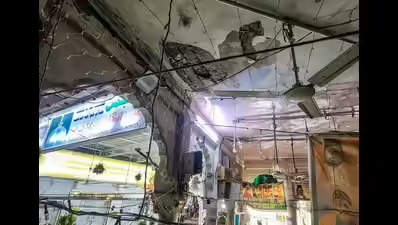NEW DELHI – The sacred Ajmer Dargah, resting place of the revered 13th-century Sufi saint Khwaja Moinuddin Chishti, has become the center of public anger and concern following repeated structural collapses caused by heavy monsoon rains. Within just two weeks, sections of the dargah’s ceiling and walls caved in, raising alarms about the safety of visitors and the apparent neglect of its maintenance.
On July 2, during the sixth of Muharram, a wall near Baba Farid’s Hujra gave way amid heavy rainfall. Merely 14 days later, a portion of the roof collapsed elsewhere in the complex. These incidents have highlighted severe structural vulnerabilities. A similar scare had occurred in 2020 when a towering ceremonial lamp (chiragh) fell — a disaster averted only due to reduced footfall during the COVID-19 lockdown.
The Dargah Committee, established under the Dargah Khwaja Saheb Act, 1955, is now under scrutiny for failing to maintain the sanctity and safety of the dargah. Local Muslims, politicians, and community leaders have condemned the committee’s inaction, alleging that restoration warnings and offers from donors were ignored for years.
Congress MLA Rafiq Khan has written to Prime Minister Narendra Modi, appealing for urgent intervention and accusing the central government of turning a blind eye. “It’s not enough to send a chadar every year. The shrine’s physical upkeep is a legal and moral obligation,” Khan said.
AIMIM president Asaduddin Owaisi also joined the chorus of criticism, calling it a “classic case of bad governance.” He questioned the Union government’s failure to protect a site that hosts nearly 20,000 devotees daily.
Khan further demanded accountability from Dargah Nazim Bilal Khan and a thorough safety audit of the premises, citing administrative failure due to the lack of a formally appointed Dargah Committee for the past three years.
Syed Sarwar Chishty of the Anjuman Khuddam Syedzadgan, representing the hereditary caretakers (Khadims), called the government’s control over the dargah “illegal occupation” and said the Khadims had now taken it upon themselves to monitor structural risks. He warned of widespread water seepage and the danger of further damage.
The nine-member Dargah Committee, whose appointments are politically influenced, manages endowments and oversees the shrine’s operations. However, past allegations of misuse have clouded its credibility. In 2019, the Committee was accused of political activities inside the dargah premises in violation of election conduct rules.
Despite a 2018 MoU signed between the Dargah Committee, Ajmer Municipal Corporation, and Hindustan Zinc for a ₹5.68 crore restoration project, very little progress has been made. Even inclusion in the Swachh Iconic Places campaign under the Swachh Bharat Mission has failed to yield results.
The dargah, which hosted the 813th Urs earlier this year with participation from 89 Pakistani pilgrims, remains a symbol of India’s syncretic culture. Yet, today it stands in a state of neglect, symbolic of misplaced priorities and administrative indifference.




